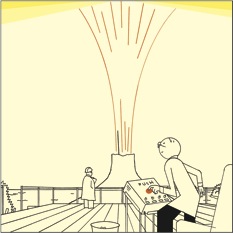
Elisabeth Kolbert tears apart SuperFreakonomics in the New Yorker this week. In the sequel to Freakanomics, authors Steven D. Levitt and Stephen J. Dubner continue their trend of grossly misinterpreting statistics and misprepresenting the truth. They go so far as to suggest some geoengineering fixes for climate change. From the review:
One scheme that Levitt and Dubner endorse features a fleet of fibreglass boats equipped with machines that would increase the cloud cover over the oceans. Another calls for constructing a vast network of tubes for sucking cold water from the depths of the sea to the surface. Far and away their favorite plan involves mimicking volcanoes.
During a major eruption, huge quantities—up to tens of millions of tons—of sulfur dioxide are shot into the atmosphere. Once aloft, the SO2 reacts to form droplets known as sulfate aerosols, which float around for months. These aerosols act like tiny mirrors, reflecting sunlight back into space. The net result is a cooling effect. In the year following the eruption of Mt. Pinatubo, in the Philippines, average global temperatures fell, temporarily, by about one degree Fahrenheit.
“Once you eliminate the moralism and the angst, the task of reversing global warming boils down to a straightforward engineering problem,” Levitt and Dubner write. All we need to do is figure out a way to shoot huge quantities of sulfur dioxide into the stratosphere on our own. This could be done, they say, by sending up an eighteen-mile-long hose: “For anyone who loves cheap and simple solutions, things don’t get much better.”
Neither Levitt, an economist, nor Dubner, a journalist, has any training in climate science—or, for that matter, in science of any kind. It’s their contention that they don’t need it. The whole conceit behind “SuperFreakonomics” and, before that, “Freakonomics,” which sold some four million copies, is that a dispassionate, statistically minded thinker can find patterns and answers in the data that those who are emotionally invested in the material will have missed. (The subtitle of “Freakonomics,” published in 2005, is “A Rogue Economist Explores the Hidden Side of Everything.”) In this way, Levitt and Dubner claim to have solved the mystery of why crime, after soaring in the nineteen-eighties, dropped in the nineteen-nineties. (The explanation, they say, is the legalization of abortion, some eighteen years earlier.) They also have proved—at least to their own satisfaction—that names like Ansley and Philippa will be popular for girls in the coming decade, that reading to your kids doesn’t matter, and that drunks should be encouraged to drive rather than walk.
“SuperFreakonomics” and Climate Change [The New Yorker]
